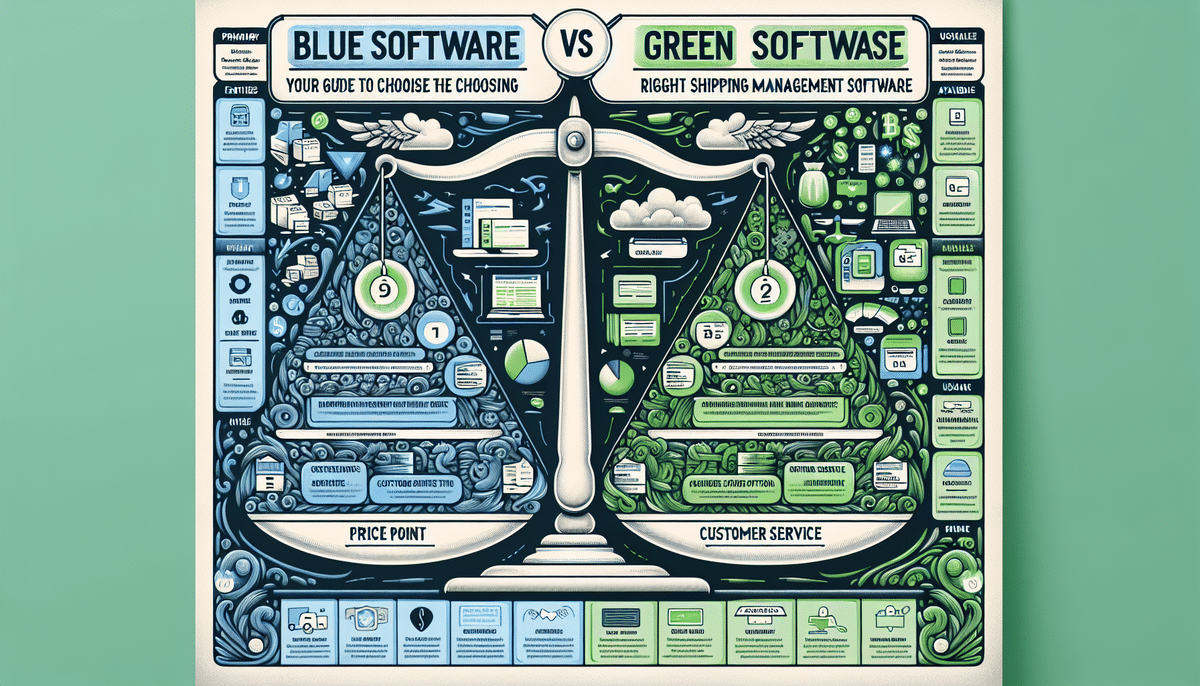ShippingEasy vs Ordoro: Comprehensive Comparison for 2024
Are you in the market for shipping management software? With numerous options available, two of the most popular choices are ShippingEasy and Ordoro. In this article, we provide an in-depth comparison of both platforms, examining their features, ease of use, pricing, integrations, shipping carrier options, and customer support. We also explore user reviews and feedback, outline the pros and cons of each platform, and offer our verdict on which is best suited for small businesses versus medium to large enterprises. Continue reading for a thorough analysis of ShippingEasy vs Ordoro.
Introduction to Shipping Management Software
Modern businesses rely heavily on shipping products to customers. Efficient shipping management software is vital for streamlining the process and minimizing errors. The right solution can reduce labor costs, lower shipping fees, improve shipping times, and enhance overall business operations. With a variety of options available, selecting the appropriate software can be challenging.
When choosing shipping management software, it's important to consider your specific business needs. Some software may be better suited for small businesses with lower shipping volumes, while others are designed for larger companies with more complex requirements. Additionally, look for software that integrates seamlessly with your existing systems, such as your e-commerce platform or inventory management software. Investing time in researching and selecting the right shipping management software can ultimately save your business time and money, while improving customer satisfaction.
Overview of ShippingEasy and Ordoro
What is ShippingEasy?
ShippingEasy is a cloud-based shipping and inventory management solution tailored for e-commerce businesses. It is renowned for its quick setup, user-friendly interface, and extensive integrations with major shipping carriers, e-commerce platforms, marketplaces, and shopping carts. The platform automates shipping, tracking, and return labels and includes advanced features for inventory management, order management, and analytics.
A key benefit of ShippingEasy is its ability to save businesses time and money. By automating the shipping process, businesses can reduce the time spent on manual tasks such as printing labels and tracking shipments. Additionally, ShippingEasy offers discounted shipping rates through partnerships with major carriers, resulting in significant cost savings. With its advanced features and cost-saving benefits, ShippingEasy is a valuable tool for any e-commerce business looking to enhance their order fulfillment process.
What is Ordoro?
Ordoro is a cloud-based order and inventory management platform designed to simplify shipping for small to mid-sized e-commerce businesses. Ordoro's standout features include intuitive order management, robust inventory tracking, and easy-to-use shipping label generation. It automates the printing of shipping labels and packing slips and integrates with various shipping carriers and e-commerce platforms.
Additionally, Ordoro offers advanced reporting and analytics tools that allow businesses to track sales, inventory levels, and shipping costs. This data can be used to make informed decisions about pricing, product offerings, and shipping strategies. Ordoro also provides a centralized dashboard that offers a real-time view of orders, inventory, and shipping status, facilitating efficient order management and fulfillment.
Feature Comparison
Both ShippingEasy and Ordoro offer similar features such as automating shipping and order management, inventory tracking, and label printing. However, ShippingEasy includes additional integrations, including email marketing and customer management features. It also provides advanced analytics tools, reporting, and invoice customization options, making it an all-in-one solution for e-commerce businesses. On the other hand, Ordoro emphasizes order management and inventory tracking, making it a better choice for businesses with more complex warehouse management needs.
Another significant difference is their pricing structure. ShippingEasy offers a free plan for businesses that ship up to 50 orders per month, while Ordoro does not have a free tier. ShippingEasy also provides discounted shipping rates through partnerships with major carriers, potentially saving businesses money on shipping costs. Ordoro, conversely, offers more flexible pricing options for businesses with high-volume shipping needs.
Regarding customer support, both platforms offer email and phone support, along with online resources such as knowledge bases and video tutorials. However, ShippingEasy also includes live chat support, offering a more convenient option for businesses needing quick assistance. Additionally, ShippingEasy assigns a dedicated account manager to each customer, providing personalized support and guidance to help businesses optimize their shipping and order management processes.
Pricing Comparison
Both ShippingEasy and Ordoro utilize tiered pricing models based on the needs of the business. ShippingEasy starts at $29/month for up to 50 shipments per month, while Ordoro begins at $59/month for up to 500 orders per month. While ShippingEasy may appear more affordable initially, Ordoro’s starting plan includes a higher number of orders per month. Therefore, ShippingEasy might be more cost-effective for businesses with many small orders, whereas Ordoro could be more economical for those handling fewer, larger orders.
It's essential to note that both platforms offer additional features and services at higher pricing tiers. For example, ShippingEasy's premium plan includes access to discounted USPS rates and advanced reporting tools, while Ordoro's higher-tier plans offer features such as comprehensive inventory management and multi-channel selling capabilities. Businesses should carefully assess their needs and budget when selecting a plan.
Additionally, consider the level of customer support provided by each platform. ShippingEasy offers phone, email, and chat support to all customers, while Ordoro provides phone and email support during regular business hours, with additional support available for an extra fee. Depending on your business's technical expertise and support requirements, this could influence your choice between the two platforms.
Integrations and Shipping Carrier Options
Both ShippingEasy and Ordoro support integrations with multiple platforms, including shopping carts, marketplaces, and shipping carriers. ShippingEasy offers more integrations with e-commerce platforms, including popular options like Shopify, BigCommerce, Etsy, and eBay. Ordoro, on the other hand, integrates with vendor platforms such as QuickBooks, Brightpearl, and SkuVault. The relevance of these integrations depends on your business’s specific needs.
In terms of shipping carriers, ShippingEasy integrates with carriers like USPS, FedEx, UPS, DHL, and more, providing a broader range of options compared to Ordoro, which integrates with USPS, FedEx, UPS, Canada Post, and Royal Mail. When choosing between these platforms, consider which carriers you currently use or plan to use in the future.
Customer Support and User Feedback
ShippingEasy and Ordoro both offer robust customer support options, including phone, email, and live chat. ShippingEasy provides a comprehensive knowledge base and video tutorials, while Ordoro features a detailed help center with FAQs and community forums. ShippingEasy's 24/7 support availability and dedicated account managers can be particularly beneficial for businesses operating outside traditional business hours or those requiring personalized assistance.
User reviews for both platforms are overwhelmingly positive. ShippingEasy users commend the platform for its ease of use and extensive feature set, while Ordoro users appreciate its intuitive interface and responsive customer support team. According to [G2](https://www.g2.com/compare/shippingeasy-vs-ordoro), ShippingEasy holds a higher average rating primarily due to its user-friendly design and customer service.
Pros and Cons of Each Platform
ShippingEasy Pros:
- Extensive integrations with e-commerce platforms
- Advanced analytics and reporting tools
- User-friendly and intuitive interface
- Wide range of shipping carrier options
- Live chat support and dedicated account managers
ShippingEasy Cons:
- Higher starting price compared to some competitors
- May include features unnecessary for smaller businesses
Ordoro Pros:
- Competitive starting price with higher order volume
- Excellent for businesses with complex warehouse management
- Intuitive order management and inventory tracking
- Flexible pricing options for high-volume shippers
Ordoro Cons:
- Fewer integrations with e-commerce platforms
- Interface can appear cluttered
- Limited shipping carrier options compared to ShippingEasy
- No mobile app available
Best Fit for Different Business Sizes
Which Platform is Best for Small Businesses?
For small businesses, ShippingEasy is highly recommended. Its user-friendly interface, extensive integrations with various e-commerce platforms, and a wide range of shipping carrier options make it an excellent choice. Additionally, ShippingEasy’s pricing tiers are cost-effective, especially for businesses handling numerous small orders. The availability of a free plan for up to 50 orders per month provides an accessible entry point for startups and small enterprises.
Which Platform is Best for Medium to Large Businesses?
For medium to large businesses, Ordoro stands out. Its focus on comprehensive order management and robust inventory tracking makes it ideal for businesses with complex warehouse management needs. Ordoro’s pricing model, which accommodates fewer but larger orders, is suited for businesses dealing with bulk shipments. Additionally, its flexible pricing options cater to high-volume shippers, providing scalability as businesses grow.
Final Verdict: ShippingEasy vs Ordoro
Ultimately, the best choice between ShippingEasy and Ordoro depends on your business’s specific needs, particularly regarding order size and complexity. Both platforms offer robust shipping management solutions that can save time and money while enhancing customer service. ShippingEasy is ideal for small to medium businesses seeking a user-friendly interface with extensive integrations and a wide range of shipping carriers. In contrast, Ordoro is better suited for medium to large businesses requiring advanced order and inventory management capabilities.
Evaluate the pros and cons of each platform in relation to your business requirements to determine the best fit. By implementing an effective shipping management solution, you can streamline your operations, reduce costs, and focus on growing your core business activities.




















